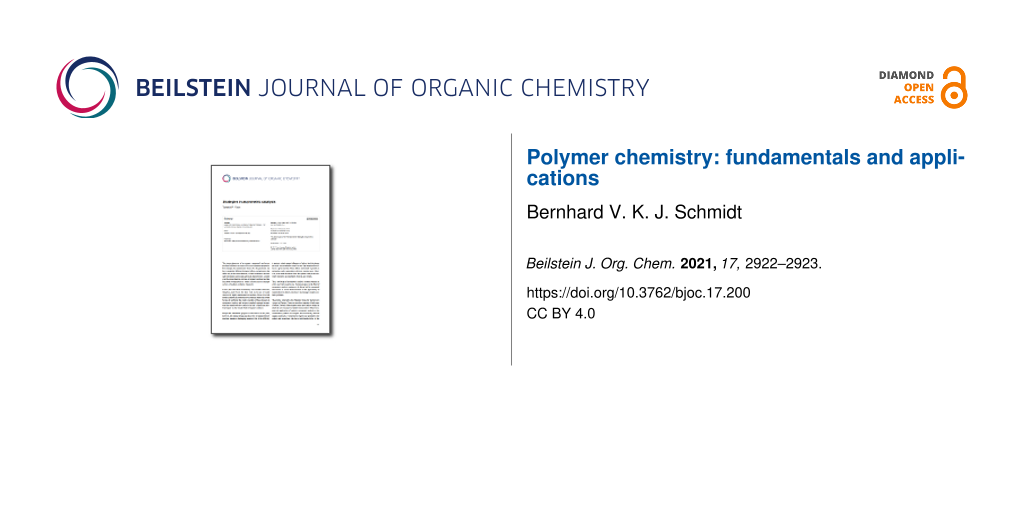Ever since the introduction of the term macromolecule and the early days of polymer science [1], organic chemistry and polymer chemistry have been closely related [2]. It only seems to be a logical step to give room for a thematic issue on polymer chemistry in the Beilstein Journal of Organic Chemistry. The connection between organic and polymer chemistry has been highlighted frequently [3,4], up to the point where one can talk about macroorganic chemistry, where oligomers bring molecular precision from organic chemistry together with materials properties from polymer chemistry [5]. Especially in the challenge of transformation to a more sustainable polymer science, organic chemistry can give significant support in the development of greener polymer materials [6].
This thematic issue covers a broad range of current topics in polymer chemistry, from synthesis to materials and applications. In the area of synthetic methods, the use of click photochemistry in polymer and organic molecule synthesis is presented, as well as the combination of polymers with supramolecular chemistry for the assembly of polymer fibers and the synthesis of well-defined polysaccharides. In the direction of materials, cryogels and reinforced hydrogels are discussed, as well as 3D-printed poly(caprolactone) biomaterials. In addition, properties of thermoresponsive materials and self-healing materials are presented in this thematic issue. Finally, the use of polymerization-induced self-assembly for the synthesis of drug carriers is presented. The issue also shows the multidisciplinary character of polymer science, for example when supramolecular motifs, organic coupling reactions or photocatalysis are employed in the development of new polymer materials in order to address specific applications.
Overall, I hope the thematic issue “Polymer chemistry: fundamentals and applications” highlights the breadth of current polymer research and enables the reader to dive into this fascinating area of chemistry. I want to express my gratitude to all authors who showcase their excellent work in this thematic issue and the Editorial Team for the magnificent organization.
Bernhard V. K. J. Schmidt
Glasgow, November 2021
References
-
Staudinger, H. Ber. Dtsch. Chem. Ges. 1920, 53, 1073–1085. doi:10.1002/cber.19200530627
Return to citation in text: [1] -
Mülhaupt, R. Angew. Chem., Int. Ed. 2004, 43, 1054–1063. doi:10.1002/anie.200330070
Return to citation in text: [1] -
Sumerlin, B. S.; Vogt, A. P. Macromolecules 2010, 43, 1–13. doi:10.1021/ma901447e
Return to citation in text: [1] -
Hawker, C. J.; Wooley, K. L. Science 2005, 309, 1200–1205. doi:10.1126/science.1109778
Return to citation in text: [1] -
van Genabeek, B.; Lamers, B. A. G.; Hawker, C. J.; Meijer, E. W.; Gutekunst, W. R.; Schmidt, B. V. K. J. J. Polym. Sci. 2021, 59, 373–403. doi:10.1002/pol.20200862
Return to citation in text: [1] -
Llevot, A.; Dannecker, P.-K.; von Czapiewski, M.; Over, L. C.; Söyler, Z.; Meier, M. A. R. Chem. – Eur. J. 2016, 22, 11510–11521. doi:10.1002/chem.201602068
Return to citation in text: [1]
| 1. | Staudinger, H. Ber. Dtsch. Chem. Ges. 1920, 53, 1073–1085. doi:10.1002/cber.19200530627 |
| 6. | Llevot, A.; Dannecker, P.-K.; von Czapiewski, M.; Over, L. C.; Söyler, Z.; Meier, M. A. R. Chem. – Eur. J. 2016, 22, 11510–11521. doi:10.1002/chem.201602068 |
| 5. | van Genabeek, B.; Lamers, B. A. G.; Hawker, C. J.; Meijer, E. W.; Gutekunst, W. R.; Schmidt, B. V. K. J. J. Polym. Sci. 2021, 59, 373–403. doi:10.1002/pol.20200862 |
| 3. | Sumerlin, B. S.; Vogt, A. P. Macromolecules 2010, 43, 1–13. doi:10.1021/ma901447e |
| 4. | Hawker, C. J.; Wooley, K. L. Science 2005, 309, 1200–1205. doi:10.1126/science.1109778 |
| 2. | Mülhaupt, R. Angew. Chem., Int. Ed. 2004, 43, 1054–1063. doi:10.1002/anie.200330070 |
© 2021 Schmidt; licensee Beilstein-Institut.
This is an open access article licensed under the terms of the Beilstein-Institut Open Access License Agreement (https://www.beilstein-journals.org/bjoc/terms), which is identical to the Creative Commons Attribution 4.0 International License (https://creativecommons.org/licenses/by/4.0). The reuse of material under this license requires that the author(s), source and license are credited. Third-party material in this article could be subject to other licenses (typically indicated in the credit line), and in this case, users are required to obtain permission from the license holder to reuse the material.








